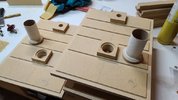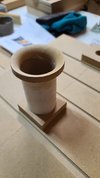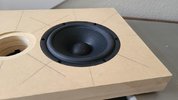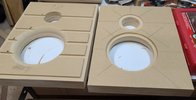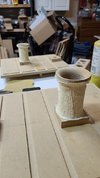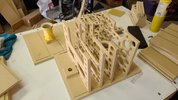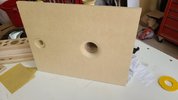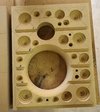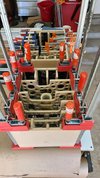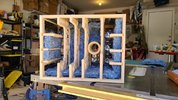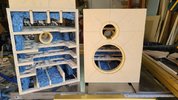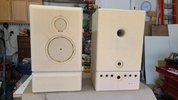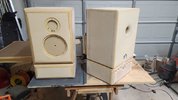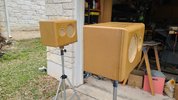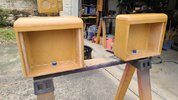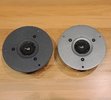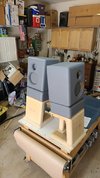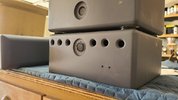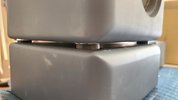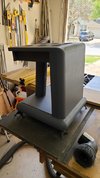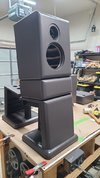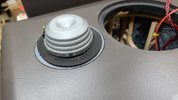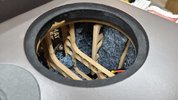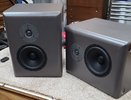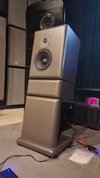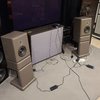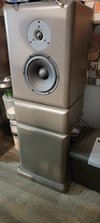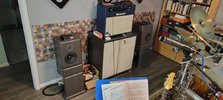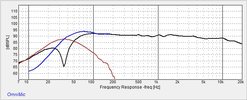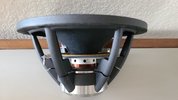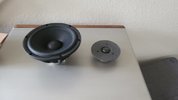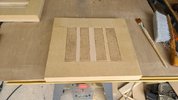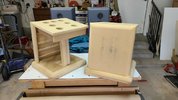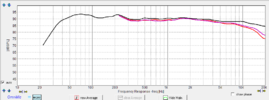I thought it would be fun to share a set of very high end loudspeakers I designed and built nearly 3 years ago.
The goal was to make them simple unique in appearance and fully integrated to the base/stands the way the original Energy loudspeaker from the 1980s was built. I always envied that speaker - the first commercial product that came from the research Dr. Floyd Toole was doing with the Canadian Research Council.
I chose a very high quality 7.5" Mid-Woofer with Papyrus cone material and an extremely well-respected motor and suspension design. While not "cheap", it also was far from expensive, like the Elliptical voice coil transducers I used in my main reference system, nor the unique looking low distortion midrange transducer Heeman is using in his new project. From a internation company, Satori, it offers extremely high dynamic range, low distortion for its price, excellent midrange performance for its large size, and a very workable dispersion pattern. While I didn't expect it when I chose it, the finished product produces deeper and cleaner real bass than I had imagined it would be capable. So, a big win for me as it exceeded my expectations.
For the tweeter I went with one of my surplus Morel Supreme Silk Dome tweeters from my old reference rig I built way back in 2008, or so. At the time, I considered these tweeters by far the best available to small purchasers like me, and they still compete very favorably in the high-end soft dome tweeter market today.
As my common preference for fullrange loudspeaker systems is the bass performance provided by carefully optimized vented enclosure loading for the woofers, I worked initially with a QB3 alignment for these woofers and while impressed, decided to try out a SBB4 alignment which I found better for the fixed height and intended "against the-wall" placement I was designing these to sound best with. After building three prototype enclosures to get the design as ideal as I could, I settled on the final design you can see in the images I am posting below. I made my own flared ports and braced the enclosure far greater than I had ever attempted before, which was extremely time consuming. All that bracing vastly increased the loading efficiency of the enclosure on the woofer, so the bass performance was significantly more tight, dynamic, and powerful in the finished product than the prototype provided.
The layout on the baffle was my signature prime number offset to reduce the audible effects of edge diffraction, and I made the baffle 2-1/4" thick so I could apply a very large radius round-over to additionally reduce edge diffraction, thus improving the clarity, imaging/soundstage, and resolution in the midrange. To break up internal standing waves, the bane of many squared rectangular enclosures, not only did I install an optimum amount of acoustic damping material (in this case cotton insulation), the bracing had randomly placed openings for airflow which would break up some standing wave, and then I created a bunch of variously sized "divots" in the back of the front baffle. This will reduce resonances that sound like ringing and add distortion to the signal, but the overall midrange resolution is improved.
The stands were in two pieces, an angled base stand that any ol' speaker could theoretically fit on, and an open enclosure shaped the same as the loudspeakers in which I had intended to place all the electronics once completed. Since I left them where they were once I completed tuning the crossovers, I haven't bothered to move the electronics into those enclosures. That will be a project for another day.
Since these were intended from-the-get-go to be fully active speakers, I acquired two stereo 80Wpc class-D amps from the Asian company, Fosi Audio, my go to for all audio amps at present, regardless of budget. I also picked up a MiniDSP 2x4 HD DSP that supports four outputs and both analog and digital inputs.
In the following posts I'll share a bunch of photos. I'd love to hear any questions of comments y'all might have .for me.
Cheers!
The goal was to make them simple unique in appearance and fully integrated to the base/stands the way the original Energy loudspeaker from the 1980s was built. I always envied that speaker - the first commercial product that came from the research Dr. Floyd Toole was doing with the Canadian Research Council.
I chose a very high quality 7.5" Mid-Woofer with Papyrus cone material and an extremely well-respected motor and suspension design. While not "cheap", it also was far from expensive, like the Elliptical voice coil transducers I used in my main reference system, nor the unique looking low distortion midrange transducer Heeman is using in his new project. From a internation company, Satori, it offers extremely high dynamic range, low distortion for its price, excellent midrange performance for its large size, and a very workable dispersion pattern. While I didn't expect it when I chose it, the finished product produces deeper and cleaner real bass than I had imagined it would be capable. So, a big win for me as it exceeded my expectations.
For the tweeter I went with one of my surplus Morel Supreme Silk Dome tweeters from my old reference rig I built way back in 2008, or so. At the time, I considered these tweeters by far the best available to small purchasers like me, and they still compete very favorably in the high-end soft dome tweeter market today.
As my common preference for fullrange loudspeaker systems is the bass performance provided by carefully optimized vented enclosure loading for the woofers, I worked initially with a QB3 alignment for these woofers and while impressed, decided to try out a SBB4 alignment which I found better for the fixed height and intended "against the-wall" placement I was designing these to sound best with. After building three prototype enclosures to get the design as ideal as I could, I settled on the final design you can see in the images I am posting below. I made my own flared ports and braced the enclosure far greater than I had ever attempted before, which was extremely time consuming. All that bracing vastly increased the loading efficiency of the enclosure on the woofer, so the bass performance was significantly more tight, dynamic, and powerful in the finished product than the prototype provided.
The layout on the baffle was my signature prime number offset to reduce the audible effects of edge diffraction, and I made the baffle 2-1/4" thick so I could apply a very large radius round-over to additionally reduce edge diffraction, thus improving the clarity, imaging/soundstage, and resolution in the midrange. To break up internal standing waves, the bane of many squared rectangular enclosures, not only did I install an optimum amount of acoustic damping material (in this case cotton insulation), the bracing had randomly placed openings for airflow which would break up some standing wave, and then I created a bunch of variously sized "divots" in the back of the front baffle. This will reduce resonances that sound like ringing and add distortion to the signal, but the overall midrange resolution is improved.
The stands were in two pieces, an angled base stand that any ol' speaker could theoretically fit on, and an open enclosure shaped the same as the loudspeakers in which I had intended to place all the electronics once completed. Since I left them where they were once I completed tuning the crossovers, I haven't bothered to move the electronics into those enclosures. That will be a project for another day.
Since these were intended from-the-get-go to be fully active speakers, I acquired two stereo 80Wpc class-D amps from the Asian company, Fosi Audio, my go to for all audio amps at present, regardless of budget. I also picked up a MiniDSP 2x4 HD DSP that supports four outputs and both analog and digital inputs.
In the following posts I'll share a bunch of photos. I'd love to hear any questions of comments y'all might have .for me.
Cheers!

